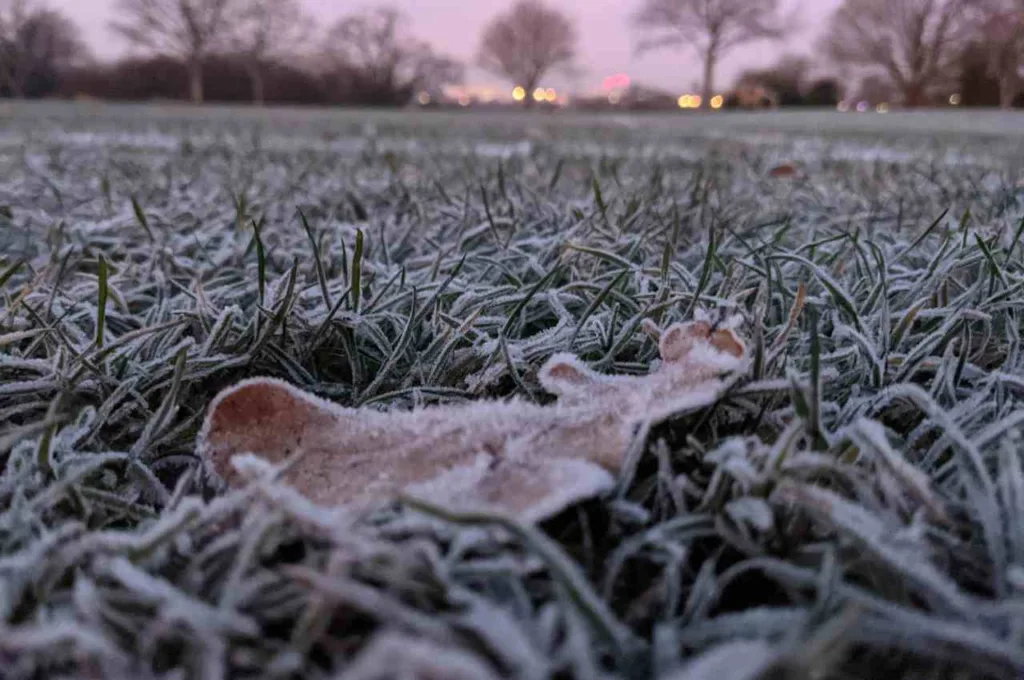Caring for your lawn in winter might not seem as important as during the warmer months, but it’s actually really important for keeping your grass healthy all year round. Many people think that because the grass isn’t growing as much in winter, it doesn’t need much attention. But properly caring for your lawn over winter can prevent damage and keep it in good shape, so it’s ready to bounce back in the spring.
In this blog post, we’ll walk you through everything you need to know about looking after your lawn during the colder months.
Table of Contents
❄️How Grass Behaves in Winter
Before we get into the bulk of the article, it’s important to understand how grass behaves in the winter, as this affects our lawn maintenance responsibilities.
During the winter, your grass goes into a state called dormancy. This means it slows down its growth to conserve energy. You might notice your lawn looking dull or even a bit brown. Don’t worry—this is normal. The grass isn’t dead; it’s just resting until warmer weather returns.
If you have cool-season grasses like fescue or ryegrass (most common in the UK), they’ll handle the cold better and should stay green longer. But your grass still won’t thrive over winter like it does in the warmer seasons.

🧐 How the UK Winter Weather Affects Our Lawns
UK winters can be tough on your lawn. The cold, wet weather can lead to problems like waterlogging and frost damage, as well as providing the perfect conditions for moss growth. Moss loves damp, shady conditions, which makes winter an ideal time for it to invade your lawn.
Heavy rainfall may cause your lawn to become soggy, making it hard for the grass roots to breathe. Frost is another problem because it can freeze the grass blades, making them brittle and more prone to damage if you walk on them.
You’ll need to keep an eye on these issues to maintain a healthy lawn through the winter months.
🤔 How to Prepare Your Lawn For Winter
A big part of winter lawn care actually takes place before winter officially arrives. Here are the steps you should take in Autumn to prepare your lawn for the cold weather
🏁 Do A Final Autumn Mow
Before winter arrives, give your lawn one last mow. Set your mower to a slightly higher setting than usual—around 2.5 to 3 inches is ideal.
Cutting your grass too short can leave it vulnerable to frost damage, while leaving it too long might lead to problems like mold. Aim for a balance that protects the grass but still keeps it tidy.
🍂 Clear Any Debris
Clear any leaves, twigs, or other debris from your lawn before winter sets in. If you leave debris on your grass, it can smother the lawn and create the perfect environment for diseases to develop.
Use a rake or a leaf blower to get the job done. It might seem like a chore, but your lawn will thank you in the spring.
🌱 Fertilisation
We strongly recommend using a winter-specific fertiliser to give your lawn the nutrients it needs to stay strong during the cold months. Look for one with a higher potassium content, as this helps strengthen the grass against cold and disease.
Apply the feed in late autumn, just before the first frost. Make sure to follow the instructions on the bag for the right amount to use.
🚜 Aerate and Overseed Your Lawn
Aerating your lawn before winter helps improve drainage and gives the roots some breathing room. You can use a garden fork or a hollow tine aerator to poke holes in the soil. This simple step can prevent waterlogging and make your lawn healthier.
If your lawn has thin patches, overseed it after aerating. The grass seed might not germinate until spring, but they’ll be ready to grow as soon as the warmer weather arrives.
📑 Our Top 5 Winter Lawn Care Tips
To keep your lawn in the best condition over winter, follow our top winter lawn care tips, shared below.
🚶🏻 Stay Off Your Lawn (When Possible!)
First, try to stay off your lawn as much as possible during winter, especially when it’s frosty. Walking on frozen grass can cause the blades to snap, which will leave your lawn looking patchy and damaged. It’s also a good idea to remove any lawn furniture for the season to prevent soil compaction.
If you need to cross the lawn, you might want to lay down a temporary path to protect the grass. Even better if you have stepping stones! Keeping foot traffic to a minimum is one of the simplest ways to keep your lawn healthy through the winter.
✂️ Mow Only If Necessary
You might not need to mow your lawn much during winter, but there could be times when it’s necessary. If the grass does grow, keep your mower on a high setting and only mow when the grass is dry.
Never cut the grass too short during winter, as this weakens it and makes it more vulnerable to frost. If in doubt, it’s better to wait until spring.
💦 Take Steps to Manage Water and Drainage
Watch out for waterlogged areas on your lawn during winter. Too much water and compacted soil can drown the grass roots, leading to bare patches or unhealthy growth.
If you notice pooling water anywhere on your lawn, try to improve drainage by aerating the soil or adding sand to low areas. You can also create small channels to help excess water drain away. Good drainage is key to preventing winter lawn problems.
🍀 Control Moss and Weeds
Moss loves winter, so you need to keep an eye on it throughout the winter months. If you see moss starting to take over, use a moss killer specifically designed for lawns. Follow up by raking out the dead moss and aerating the soil to keep it from coming back.
Weeds might also pop up during milder spells, so pull them out as soon as you see them. Keeping moss and weeds under control during winter makes your lawn look better and gives it a stronger start in spring.
☃️ Deal with Snow and Ice Appropriately
Snow can actually protect your lawn from frost, so you don’t need to remove it unless it’s a really heavy layer. But you should avoid shoveling snow onto your grass, as this can cause damage.
If ice forms on your lawn, don’t try to break it up—it’s better to let it melt naturally. Trying to remove ice can rip up the grass and cause more harm than good. Just be patient and let nature take its course.
💪 How to Help Your Lawn Recover After Winter
As winter comes to an end, take a good look at your lawn. Walk around and check for any signs of damage, such as bare patches, dead grass, or areas where moss has taken over.
Pay attention to how the lawn feels under your feet—if it’s soggy, you might need to improve drainage. This early inspection helps you spot problems before they get worse.
Early Spring Lawn Care
Once you’ve assessed your lawn, it’s time to start your recovery plan as the summer months approach.
Rake Your Lawn
Begin by gently raking the lawn to remove any leftover debris and dead grass. This helps the grass breathe and prepares it for new growth.
Overseed if Necessary
If you notice any bare spots, reseed them as soon as the soil warms up a bit. Keep the area moist to encourage seed germination.
Feed Your Lawn
Now, it’s time to give your lawn a good feed. Apply a balanced, slow-release lawn feed to kickstart the grass’s growth. Feeding your lawn in early spring ensures it gets the nutrients it needs to recover from winter and grow strong.
Do the First Mow
Finally, when the grass starts growing again, give it its first mow of the season. Set your mower to a higher setting and gradually lower it over the next few cuts.
Don’t be too eager to cut it short—giving the grass time to grow thicker will help it stay healthy throughout the year. Your patience and care now will pay off with a healthy, lush lawn as the weather warms up.
❔ More on Winter Lawn Care: FAQs
Can I fertilise my lawn in winter?
Yes, you can fertilise your lawn in winter, but it’s important to think about your timing. Apply a winter feed in late autumn, just before the first frost. This gives your lawn the essential nutrients it needs to stay strong through the cold months. Don’t fertilise during the deep winter, as the grass won’t absorb it well.
Should I rake leaves off my lawn before it snows?
Yes, absolutely, you should rake fallen leaves off your lawn before it snows. Leaving leaves on your lawn through winter can smother the grass and create a breeding ground for diseases. Rake them up before the first snowfall to keep your lawn healthy and ready for spring.
Is it okay to walk on frosty grass?
Try to avoid walking on frosty grass whenever possible since doing so can break the blades and damage your lawn, resulting in ugly brown patches. If you have to walk across your lawn, do it gently, and take the same path each time to minimise the damage.
How do I deal with snow mould on my lawn?
If you spot snow mould, lightly rake the affected area to loosen the matted grass. This will help air circulate and dry out the soil. Snow mould usually clears up on its own as the weather warms, but raking speeds up the process and prevents further damage.
Can I reseed my lawn during winter?
It’s best to wait to reseed your lawn in early spring. The seeds won’t germinate well in the cold, and you might end up wasting time and effort. Plan to reseed once the soil warms up and the grass starts growing again.
🏁 Final Word
We hope you learned everything you wanted to know about winter lawn care in this guide. If you have any more questions about how to care for your lawn over the colder seasons, we’re happy to help! Just drop us an email and we’ll get back to you as soon as possible.
